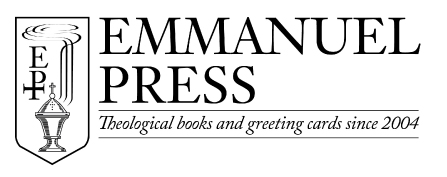THE LATEST NEWS
Update on Future Projects: Books and Cards
As we mentioned several weeks ago, we are putting the final touches on two new Christmas cards with art by Edward Riojas. These cards will be available for sale in mid-November.
Do you or your organization send out a lot of Christmas cards? We have had multiple requests for bulk orders, so we have decided to offer a limited-time bulk discount with a minimum order of 200 cards. You’ll receive 10% off of 200-299 cards; 15% off 300-399 cards, 20% off 400-499 cards, and 25% off 500+ cards. The order can be a mix of any of our four Christmas cards, combining them in sets of 10. However, bulk orders will need to be placed by October 31 in order to get these prices. Contact us for a customized invoice.
We are also excited to announce a book of Lent and Easter sermons by Rev. David Petersen of Redeemer Lutheran Church in Fort Wayne, including more than 60 sermons for the Sundays of pre-Lent, all 40 days of Lent, the Sundays after Easter, as well as saints days in TLH and LSB that fall within the season. The Sunday sermons are based on the Gospel readings from the historic one-year lectionary while the propers for the 40 sermons of Lent come from Daily Divine Service Book, edited by Rev. Heath R. Curtis. It will be an excellent resource for Lenten daily devotions for both pastors and parishioners. The projected release date for this book is late December/early January.
Also forthcoming is an updated reprint of Ceremony and Celebration by Paul H.D. Lang. This book is an invaluable resource in explaining the ceremonial of Lutheran liturgy: “Ritual refers to that part of a divine service which consists of its words, that is, the rite or the order of service…Ceremonial is everything connected with the performance of a rite. It refers not only to bodily expressions, such as speaking, singing, kneeling, bowing, making the sign of the cross, and the outward observance of the church year, but also to the ornaments, symbols, and material objects employed in the church’s worship, for example, the church building, the altar, crucifixes, candles, and vestments. Ceremonies are solemn religious things and actions. All these are, as stated, included in the term ceremonial” (Lang, Ch. 2). We plan to have this book available in early January, just in time for the Symposia at Concordia Theological Seminary here in Fort Wayne.
We will definitely post updates here and continue to send out occasional emails, but we also keep our Facebook page updated more frequently so as not to inundate you with emails along the way. You can follow us on Facebook by clicking on “Like” at the top right-hand of this page.
An Explanation of the Common Service: The Benediction

The Benediction
The Lord bless thee, and keep thee.
The Lord make His face shine upon thee, and be gracious unto thee.
The Lord lift up His countenance upon thee, and give thee peace.
__________
What is the Benediction? It is the final blessing of the people, commanded by God (Numbers 6:22-26), and always regarded by the Church as one of the most solemn parts of the Service. Says an ancient writer: “When the Benediction is pronounced, you should incline both head and body, for the blessing which is given you is the dew and rain of heaven.”
What is the nature of the Benediction? It is not a mere pious wish, but is the actual impartation of a blessing from God to the believing congregation, as we are assured in Numbers 6:27, “They [the priests] shall put my name upon the children of Israel, and I will bless them.” Because of the singular pronoun “thee,” it is highly appropriate as the conclusion of the Communion, in which through the Sacrament, the Lord has bestowed His grace upon each believer.
__________
*an excerpt from An Explanation of the Common Service, pages 66-67. (on sale through August 31)
*picture above from our Benediction notecard
An Explanation of the Common Service: The Lord’s Prayer
Our Father, who art in heaven, Hallowed be Thy Name; Thy kingdom come; Thy will be done on earth as it is in heaven; Give us this day our daily bread; And forgive us our trespasses, as we forgive those who trespass against us; And lead us not into temptation; But deliver us from evil. For Thine is the kingdom, and the power, and the glory, for ever and ever. Amen.
__________
Why did the early Church introduce this prayer into the Communion Service [the second part: the Service of the Sacrament of the Altar]?
On account of its sacredness.
(a) From ancient times it has always been regarded as a divine and spiritual form of prayer, which can never fail to move our heavenly Father, because His Son taught us thus to pray. On this Cyprian says beautifully: “What prayer can be more spiritual than that which was given us by Christ, by Whom also the Holy Spirit was sent? What petition more true before the Father than that which came from the lips of His Son, Who is the Truth?”
(b) Its use was esteemed the peculiar privilege of true believers. Hence it was said, not in the first part of the worship [the Service of the Word], where we usually have it, but in the Communion Service, from which the heathen and catechumens (the unbaptized) were excluded. The latter were strictly forbidden to utter it. Chrysostom explains thus: “Not until we have been cleansed by the washing of the sacred waters are we able to call God, Father.”
_________
An Explanation of the Common Service, pages 57-58. (on sale through August 31)
*Read about bulk order pricing here.
Seed-Grains of Prayer: Prayer for Saturday Evening
“Heavenly Father, I praise Thee that, by Thy grace, I have been permitted to put another week of trials behind me, and have not been cast away in my sins together with the godless. O Lord, my God, Who ordainest and changest times and seasons, change also my heart and mind, by Thy Holy Spirit, that this week may mark a true change of time for me, to turn me from my former impenitence, my love for the world, and my lusting desires, unto Thee alone, through faith and love, so that, if this had been my last week on earth, I might lay aside this corrupt and sinful life, and put on the incorruptible, holy life in Christ. Amen.”
Wilhelm Loehe, Seed-Grains of Prayer, #250 (on sale through August 20)
An Explanation of the Common Service: An Excellent Resource for the Congregation
“An Explanation of the Common Service is an excellent resource. It is concise and informative, and it presents to laymen and clergy alike the simplicity and strength of the historic Lutheran Service used by most North American parishes prior to the 1970-80s. I have had only positive feedback from all who have used it. This book is a superb resource for both new members and life-long Lutherans.” Rev. William Parsons, Redeemer Lutheran Church in Fairhope, AL.
After several requests from pastors to order in bulk for their Sunday School and Adult Bible classes, we now offer discounted pricing for this book: orders of 10-20 books receive 15% off; 21-30 books receive 20% off; 31+ books receive 25% off.
In addition, we have extended the sale price for this book only to August 31 so that the bulk order discount can be applied to the current sale price. It’s basically a double discount. Contact us with your order so that we can create a customized invoice for you. Our website cannot compute the bulk order discount automatically.
__________
*From the back cover:
The Common Service, with roots in the Reformation, the Middle Ages, and the early church, became the standard English liturgy for the Lutheran Church in America in the late 19th century. The Lutheran Church—Missouri Synod published it as its standard in The Lutheran Hymnal in 1941. With the publication of Lutheran Worship (1982), editors revised the Common Service, updating what they considered archaic language, but the basic structure remained the same. In the Lutheran Service Book (2006), editors have again included the Divine Service from The Lutheran Hymnal, which is the liturgy of the Common Service.
What is it about the beauty and reverence of this Divine Service that have caused Lutheran congregations to welcome it every Sunday morning for over a century? Many today enjoy it without being able to verbalize its deep theological beauty. Others may exclude it from congregational practice because they consider it outdated and invalid for the modern parishioner. In either case, the editors of An Explanation of the Common Service provide a basic yet important description of the theological and biblical meaning of this time-tested liturgy.
An Explanation of the Common Service explains the liturgy in such simple terms that it is perfect for teaching new members, catechumens, and youth. Yet its timeless truths are profound enough to instruct even long-time members and pastors. First printed a century ago, this Lutheran liturgical handbook uses questions and answers to explain the meaning of three services: the Communion service, Matins, and Vespers. (Liturgical texts are equivalent to those in The Lutheran Hymnal, 1941.) In addition, hymnody, liturgical theology, and history are addressed succinctly. The glossary of liturgical terms is helpful, extensive, and reliable.
__________
*This is an edited re-post from 5/6/11.

Let’s stay in touch! To receive the most current information on our products and new releases, join our email list today!

